Every editorial production is independently selected, though we may exist compensated or receive an chapter committee if you buy something through our links. Ratings and prices are accurate and items are in stock as of fourth dimension of publication.
What are cheese curds? If y'all've ever been to the Midwest, chances are you've eaten them by the bagful. This regional specialty is widely available beyond Wisconsin, likewise every bit Ontario and Quebec in Canada. These wrinkly, squishy pieces of fresh dairy goodness are typically served on their ain, atop poutine or battered and deep-fried.
What Are Cheese Curds?
Curds are ultra-fresh cheese $.25 known for their springy texture and squeaky audio.
Squeaky cheese curds commencement with pasteurized cow'southward milk that'due south heated to xc to 100°F, and so cultured. The culture is a strain of expert bacteria made from fermented milk. Civilization makes fresh milk more acidic, helps it curdle and ultimately gives cheese its unique texture and flavor.
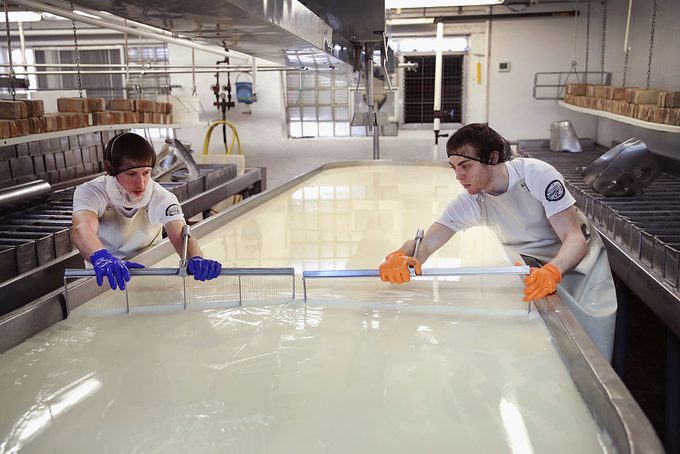 Scott Olson/Getty Images
Scott Olson/Getty Images
Side by side, the cultured milk gets coagulated by adding rennet, a clotting enzyme that separates the milk solids (curds) from the liquid (whey) and helps impart flavour. Using cheese harps (aka curd cutters or wire knives), cheesemakers cut the curds to help expel the whey. Then, in a process called "ditching," the cheesemakers push button the curds into clumps on either side of a cheese vat. The vat has a channel down the middle for draining the whey.
Why Do Cheese Curds Squeak?
Cheddaring is the process that gives cheese curds their squeak, and information technology'due south also the first step in making aged cheddar cheese. Here's how it works.
After ditching, cheesemakers slice the clumped curds into large chunks called loaves. Then, they hand-turn and stack the chunks several times while steaming them at around 100° to aid extrude more than whey.
 Scott Olson/Getty Images
Scott Olson/Getty Images
Once the pressed and drained curds take reached the correct firmness and wet level, it'due south fourth dimension to mill them into their signature squiggly shape, and so launder them with warm water. After a thorough salting, they're ready to bundle for sale.
In a large-scale professional operation, the whole curd-making process takes almost four hours from start to end and can brand thousands of pounds of cheese. Cheese curds don't demand to be refrigerated for the first 24 hours, and many people volition tell you they're all-time enjoyed straight out of the handbag (or the vat) when they're so fresh they're still warm—which is when they're at their squeakiest.
Come across why Wisconsin cheese really is the best.
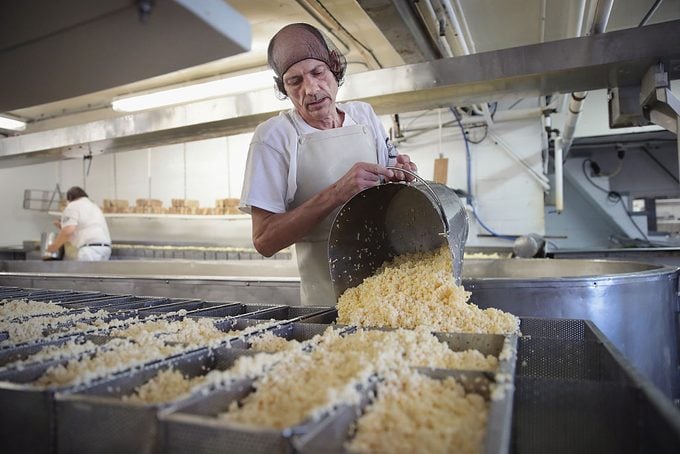 Scott Olson/Getty Images
Scott Olson/Getty Images
The Science of Squeaky Cheese
Prepare for the science behind the squeak? Cheese curds have a network of proteins. The proteins are called casein, and they're held together by calcium phosphate bonds. This springy network rebounds when you lot seize with teeth into a curd. That rebound creates vibrations that make the curds emit their signature squeak.
Why exercise curds lose their squeak? It's because of the acrid in the cheese civilization. Over time, acrid breaks down the curd'due south tight protein network and silences the squeak forever. But, culture is also how you end up with aged cheese.
Let's say you're not within driving distance of a creamery. If you must get your cheese curds from the refrigerated section, y'all can sometimes bring their squeak back.
The unofficial manner to do this is to stick the bag of curds on your dashboard while you drive home from the shop on a sunny twenty-four hour period. Merely cheese scientists at the Center for Dairy Enquiry at the University of Wisconsin-Madison have developed a more than precise method.
They've determined that after storing cheese curds at 45° (the approximate temperature of your fridge's cheese drawer) for up to two weeks, you can re-squeakify them past reheating 4 ounces of curds for 15 seconds in the microwave.
Where to Buy Wisconsin Cheese Curds
The power to extend a curd's squeak by storing them at a cold enough temperature and advisedly reheating them is good news if y'all don't live in Wisconsin (or Canada). While in that location's zilch like stopping at the gas station to pick upwards a bag that's squeaky-fresh, you can have cheese curds shipped to your doorstep for the next best thing.
Cheesemakers usually limit curd shipping to certain days of the week and times of the year to make certain y'all go the freshest possible production. Simply we say the wait is worth it! Here are some Wisconsin favorites:
- Ellsworth Creamery Cheddar Cheese Curds: Ellsworth Cooperative Creamery has been producing its famous cheddar curds since 1968. These are the same curds Wisconsinites enjoy every June at the almanac Ellsworth Cheese Festival.
- Dilapidated Wisconsin Cheese Curds by State Street Brats: These battered cheese curds are flavored with garlic, paprika and other spices. They're shipped frozen on ice, so all you lot have to practise is broil them in the oven to enjoy an authentic Wisconsin bar experience at home no thing where you live.
- Clock Shadow Creamery Cheddar Cheese Curds: These curds come from a Milwaukee cheese manufactory, located in the celebrated Walker's Point neighborhood. If you're local, you tin requite them a call to find out exactly when fresh-out-of-the-vat curds are available on Tuesdays, Wednesdays and Thursdays.
- Renard's Wisconsin Cheese Curds: If yous want award-winning curds, attempt the ones from this third-generation family endemic and operated cheesemaker that's been around since 1961.
How to Make Cheese Curds
In the Midwest, this means, "how to deep-fry cheese curds." Basically, you make a dry mixture of flour, common salt and any optional seasonings you want to include, then combine that with a wet mixture of egg, milk and beer (or buttermilk) to create a batter.
Dip the curds in the concoction, then fry them at 375° until the outside is golden brown. Restrain yourself until your freshly fried curds are cooled enough to not burn your tongue, and you'll exist in melty, crispy cheese heaven.
The Best Recipes from Wisconsin

Barbecue Brats & Peppers
We alive in brat country, and this barbecue-mode recipe feeds a oversupply. The sauce gives information technology a welcome change from the same quondam grilled bratwurst. — Maria Zrucky, Kronenwetter, Wisconsin
Land Fair Cream Puffs
The Wisconsin Bakers Association has served this cream puff recipe at our land off-white since 1924. —Ruth Jungbluth, Dodgeville, Wisconsin
Easy German Murphy Salad
This tangy murphy salad stirs memories of my grandma, who fabricated it for us. At present my mom makes it with brats and sauerkraut, truly the best meal! —Devin Mulertt, Cedarburg, Wisconsin

Deep-Fried Cheese Bites
These beer-battered cheese curds are the ultimate in delicious condolement food. Some folks like to serve them with ranch dressing, ketchup or barbecue sauce for dipping. —Katie Rose, Pewaukee, Wisconsin
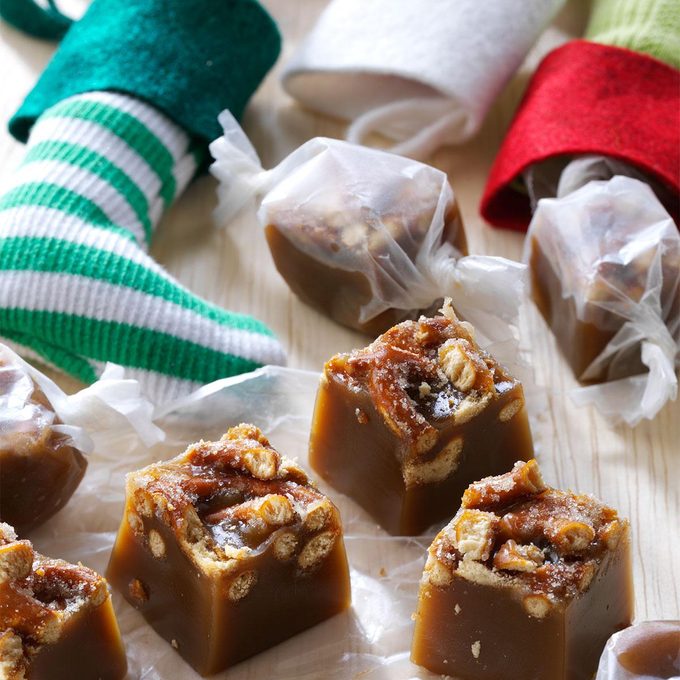
Beer and Pretzel Caramels
Beer and pretzels are a natural combination—mix them with polish caramel and you lot have an awesome candy. The guys will go wild over these crunchy, chunky chews. —Jenni Precipitous, Milwaukee, Wisconsin

Brandy Old-Fashioned Sweet
The concept of an former-fashioned dates back to the early 1800s and includes whiskey, bitters, scarlet juice, sugar and water. This old-fashioned recipe, which is extremely popular in Wisconsin, uses brandy in place of whiskey and lemon-lime soda instead of water for a milder cocktail. —Taste of Dwelling Test Kitchen
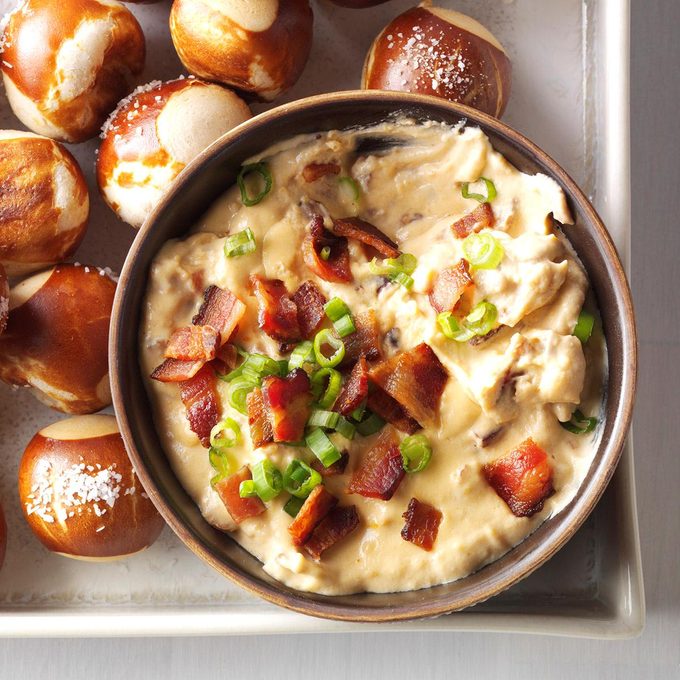
Slow-Cooker Cheddar Salary Beer Dip
My tangy, smoky dip won the superlative prize in our office party recipe contest. Other beers can work for this, merely exist sure to steer clear of night varieties. —Ashley Lecker, Green Bay, Wisconsin
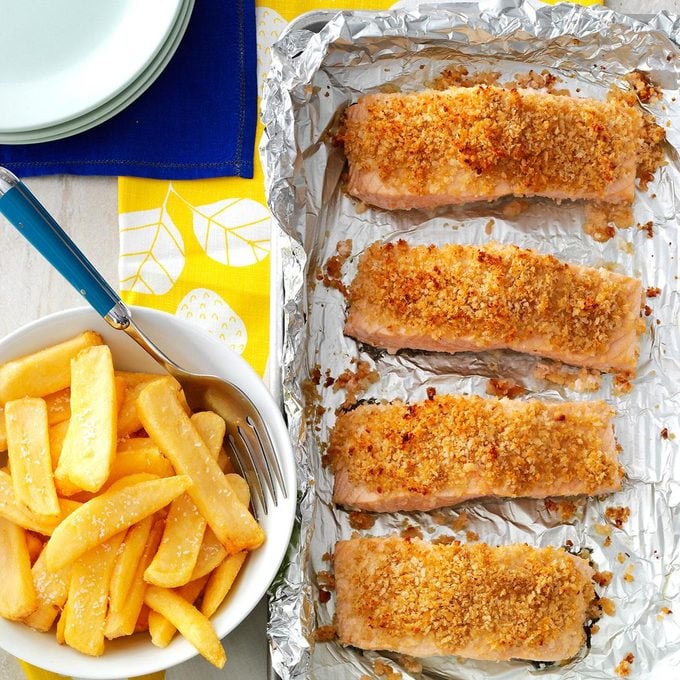
Crispy Fish & Chips
A British pub classic turns crown jewel when you add horseradish, panko and Worcestershire. You can besides attempt it with white fish like cod or haddock. —Linda Schend, Kenosha, Wisconsin
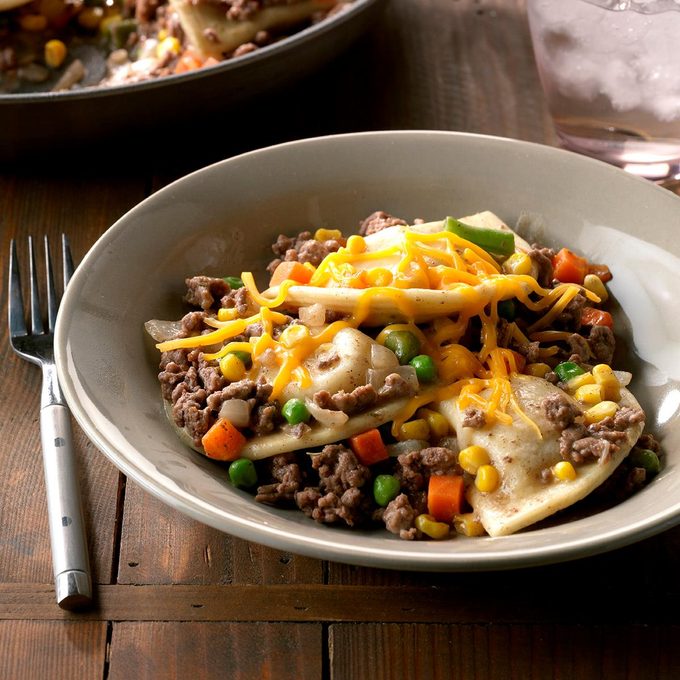
Pierogi Beef Skillet
Hearty and thick with beef, veggies and potatoes, this is a complete meal in one. —Gustation of Home Examination Kitchen
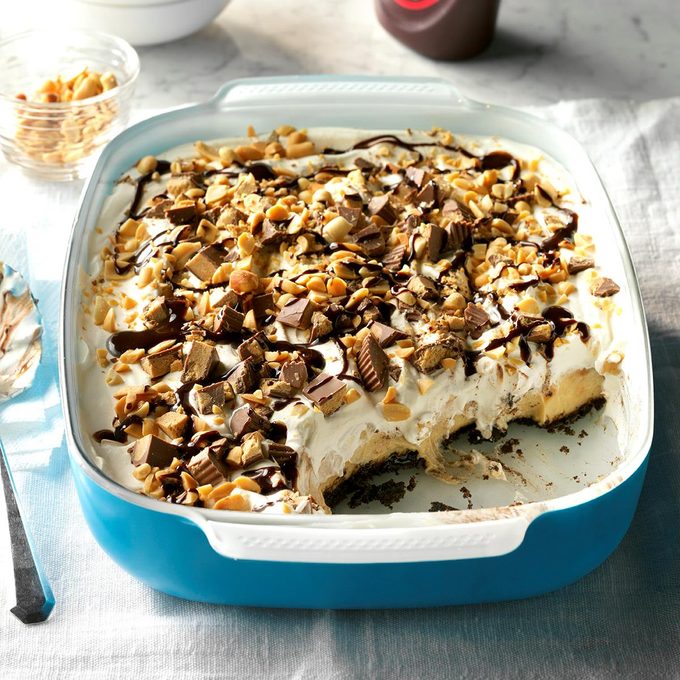
Peanut Butter Custard Nail
"Ooey, gooey, swell!" is how friends and family describe this chocolate-peanut butter dessert. I capeesh the make-ahead convenience. —Marilee Evenson, Wisconsin Rapids, Wisconsin
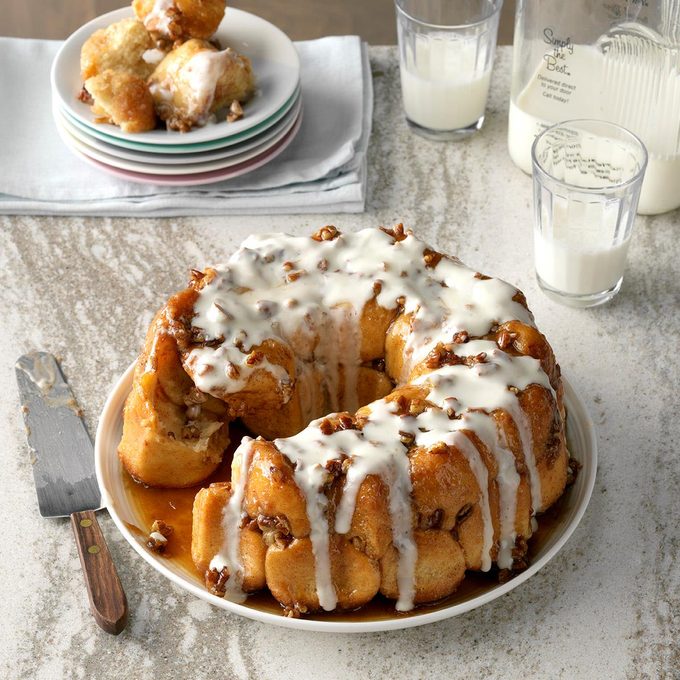
Caramel-Pecan Monkey Bread
The kids will get a kicking out of pulling off gooey pieces of this delectable monkey breadstuff. Information technology'southward hard to resist a caramel-coated treat. —Taste of Home Test Kitchen
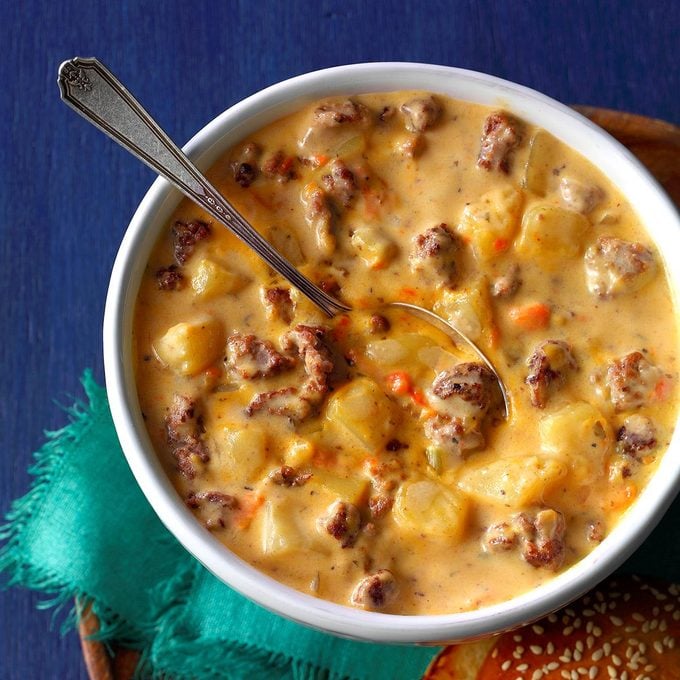
Cheeseburger Soup
A local eating place serves a similar cheeseburger soup but wouldn't share its recipe with me. I adult my ain, modifying a recipe I already had for potato soup. I was really pleased with the way this all-American dish turned out. —Joanie Shawhan, Madison, Wisconsin
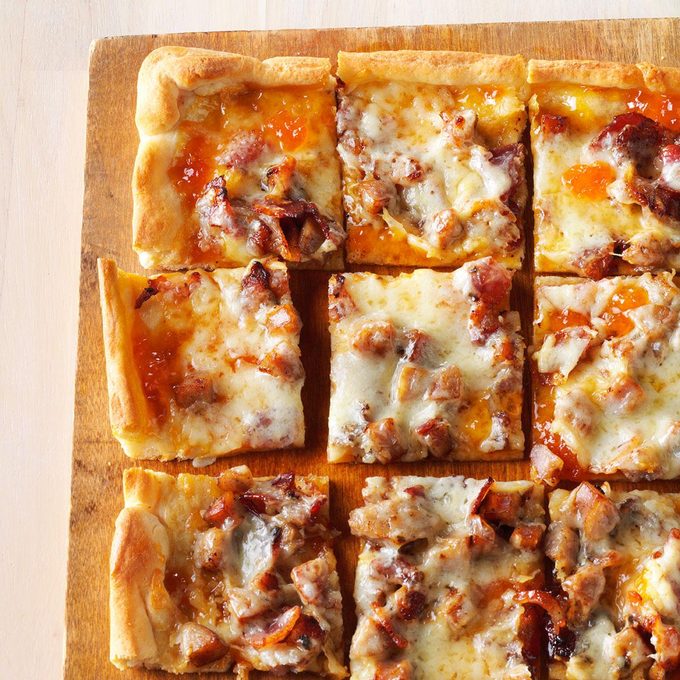
Brat & Bacon Appetizer Pizza
Chopped bratwurst and maple bacon are a fabulous way to start a pizza. I jazz upwardly this treat even more than with apricot preserves and love mustard. The snack-sized slices win over even the toughest critics. —Colleen Vrooman, Waukesha, Wisconsin
Grilled Beef & Blueish Cheese Sandwiches
Roast beef, reddish onion and blue cheese really amp upwards this palatial grilled sandwich. If you like a little heat, mix some horseradish into the spread. —Bonnie Hawkins, Elkhorn, Wisconsin

Party Fourth dimension Mini Cheeseburgers
Kids and adults alike will honey the taste of these moist and mouthwatering mini burgers. Juiced up with pickle savor and topped with cheese slices, these "sliders" will disappear in no time flat! Be sure to make plenty. —Sense of taste of Home Test Kitchen
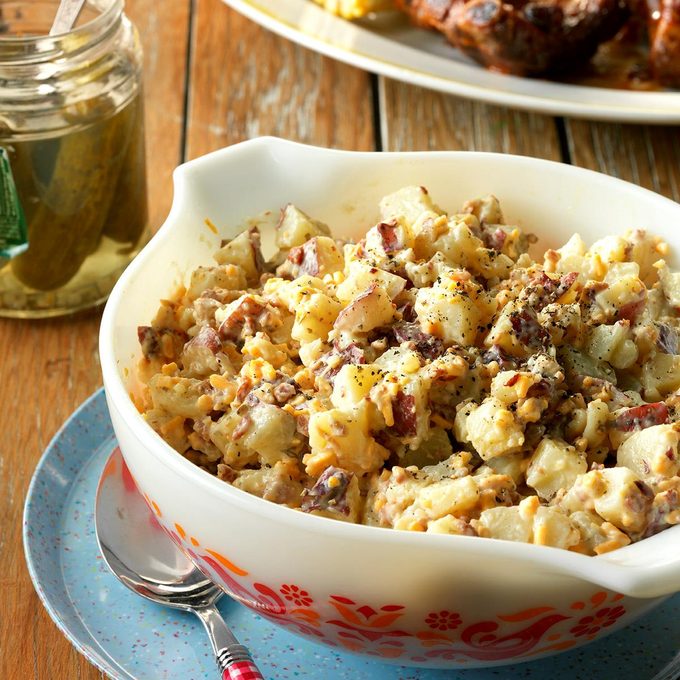
Ranch Spud Salad
I make this creamy irish potato salad with cheese, bacon and ranch salad dressing. My sister asked for the recipe as soon as she tried it. —Lynn Breunig, Wind Lake, Wisconsin
Favorite Grilled Pork Chops
This recipe is my favorite out of all my grilled pork chop recipes. I start preparing this entree the dark before I plan to grill information technology.—Erica Svejda, Janesville, Wisconsin
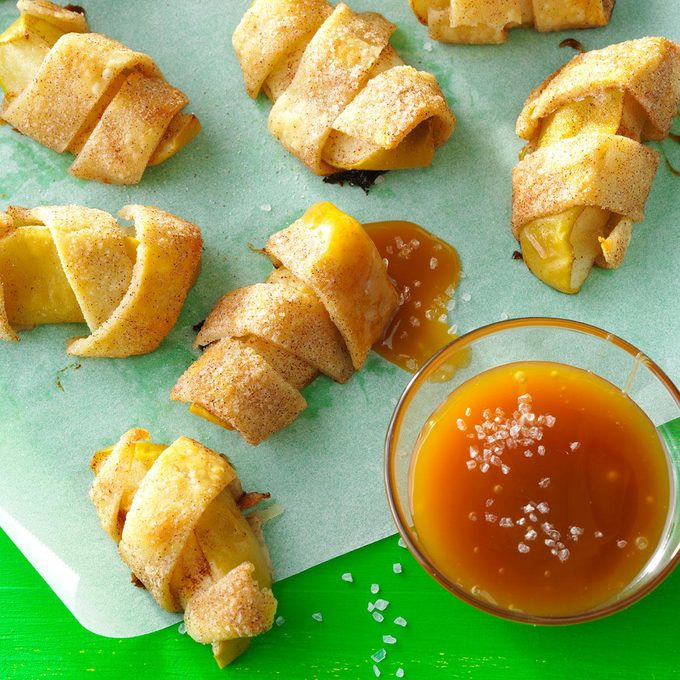
Seize with teeth-Sized Apple Pies
These little bites are fun for kids to make. Simply wrap strips of pastry effectually apple tree wedges and shake on some cinnamon-sugar. And so merely broil and watch them disappear! —Taste of Domicile Test Kitchen
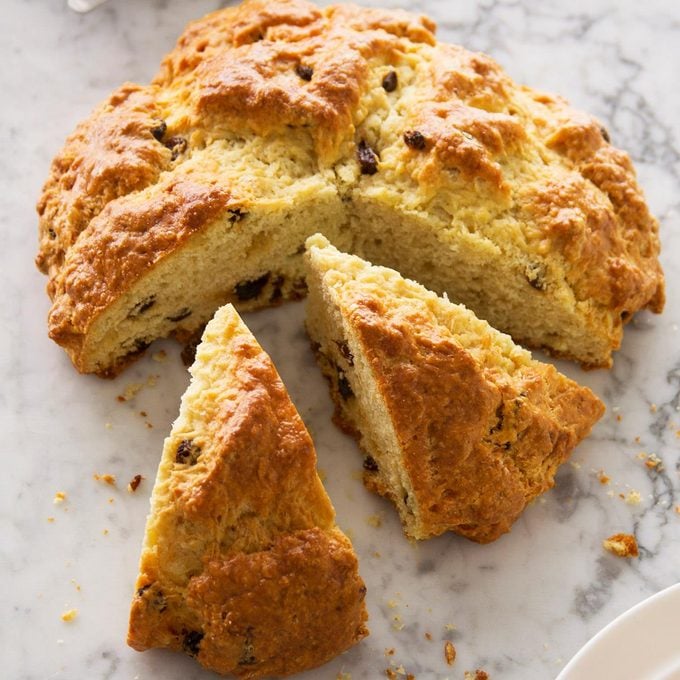
Classic Irish Soda Bread
This traditional Irish soda bread can be made with an assortment of mix-ins such equally stale fruit and nuts, but I like information technology with a handful of raisins. —Gloria Warczak, Cedarburg, Wisconsin
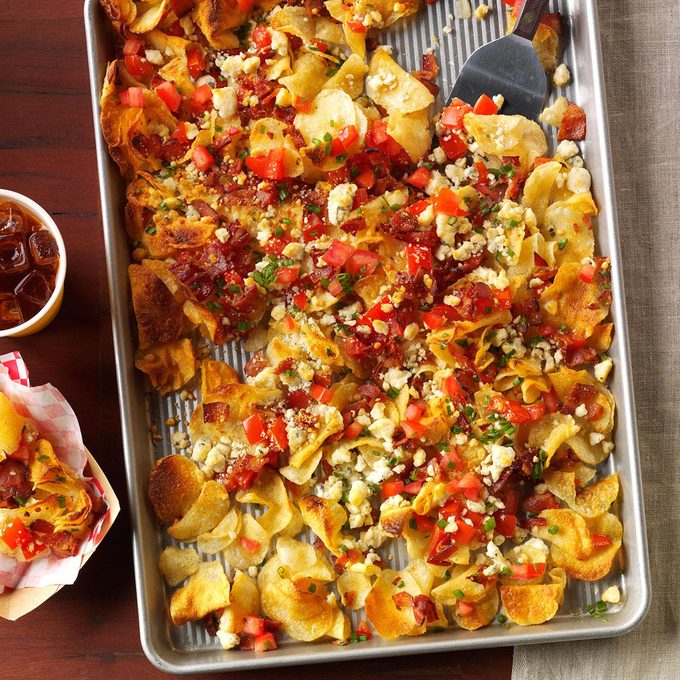
Blue Cheese Potato Fries
Game day calls for something bold. I top potato fries with tomatoes, bacon and tangy blue cheese. I make two large pans, and they always disappear. —Bonnie Hawkins, Elkhorn, Wisconsin
Grilled Seasoned Bratwurst
Whether you're hosting a picnic at domicile or at a park, cook these bratwurst on the stovetop offset. Then y'all can quickly brown them on the grill. —Taste of Dwelling Test Kitchen
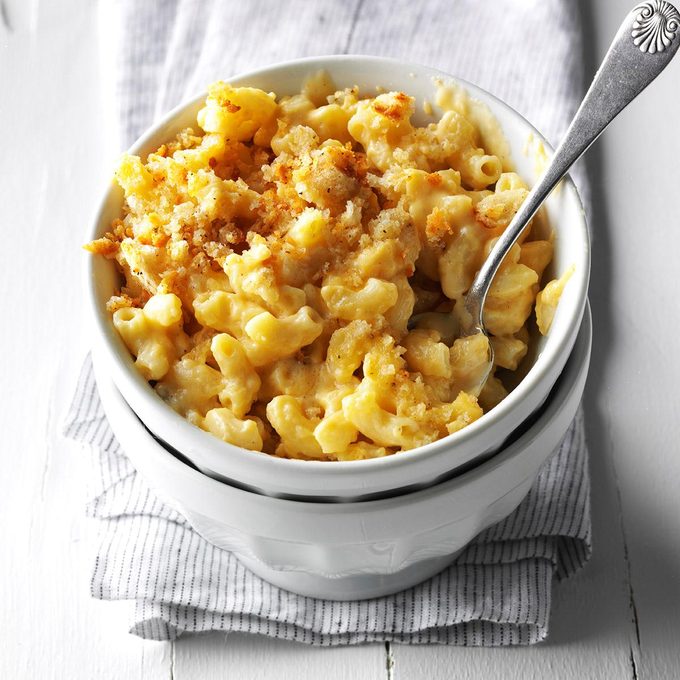
All-time Ever Mac & Cheese
To make this amazing mac, I brand a sauce loaded with three unlike cheeses to toss with the noodles. When baked, it's gooey goodness with a crunchy topping that...don't get me started! —Beth Jacobson, Milwaukee, Wisconsin
High german Vegetable Soup
My sis-in-law gave me this recipe—it'southward a nice thick soup. It does call for quite a few ingredients, just the gustation is worth information technology!—Gundrun Braker, Burnett, Wisconsin
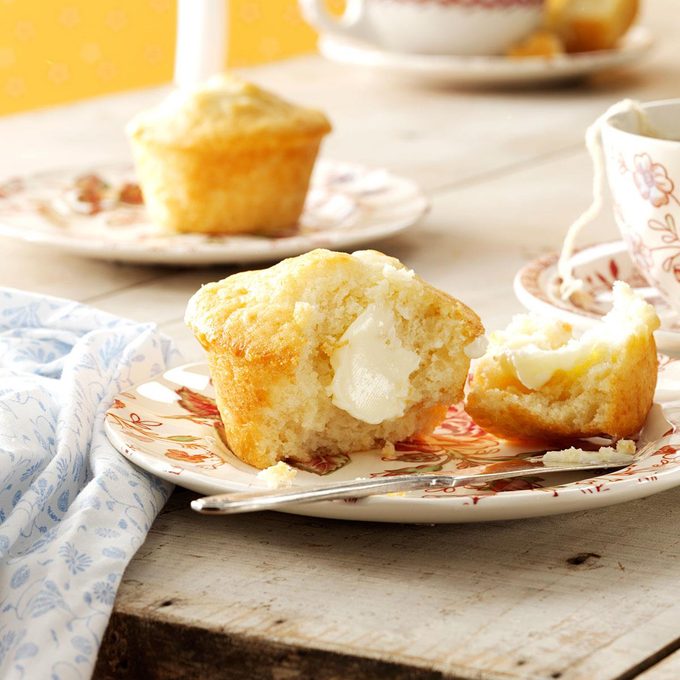
Grandma'southward Dearest Muffins
I can remember my Grandma Wheeler making these delicious muffins—we'd eat them nice and warm, fresh from the oven! She was a "pinch of this and scattering of that" kind of cook, so getting the ingredient amounts correct for the recipe was a challenge. At present information technology'due south a family treasure! —Darlis A. Wilfer, West Bend, Wisconsin
Loaded Mashed Potatoes
Tired of the same old side dish, I whipped up this new family favorite. We tin't get enough of these loaded mashed potatoes at our firm. Often, I'll set this goulash ahead and refrigerate information technology. Then I broil it just before serving. —Dawn Reuter, Oxford, Wisconsin
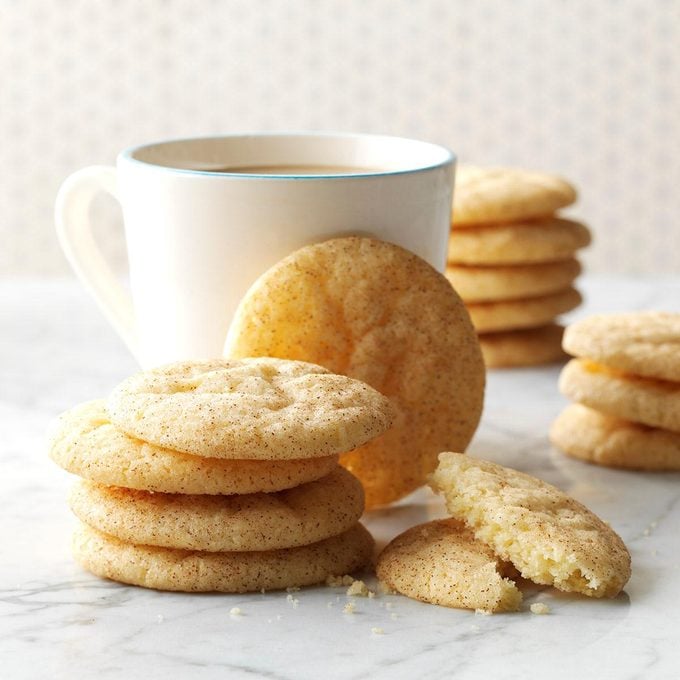
Snickerdoodles
The history of this whimsically named treat is widely disputed, merely the popularity of this archetype cinnamon-sugar-coated cookie is undeniable! —Taste of Home Test Kitchen
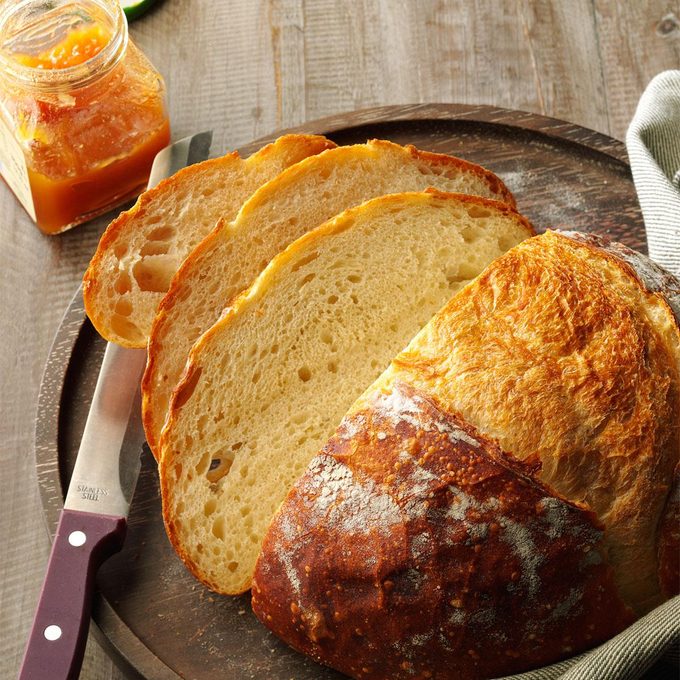
Crusty Bootleg Bread
Crackling homemade breadstuff makes an average twenty-four hours extraordinary. Enjoy this cute crusty breadstuff recipe as is, or stir in a few favorites like cheese, garlic, herbs and dried fruits. —Megumi Garcia, Milwaukee, Wisconsin
Bratwurst Supper
Later trying a few bratwurst recipes, I've found this meal-in-1 is ideal for camping since it grills to perfection in a heavy-duty foil bag. Loaded with chunks of bratwurst, red potatoes, mushrooms and carrots, it'south easy to flavor with onion soup mix and a little soy sauce. —Janice Meyer, Medford, Wisconsin
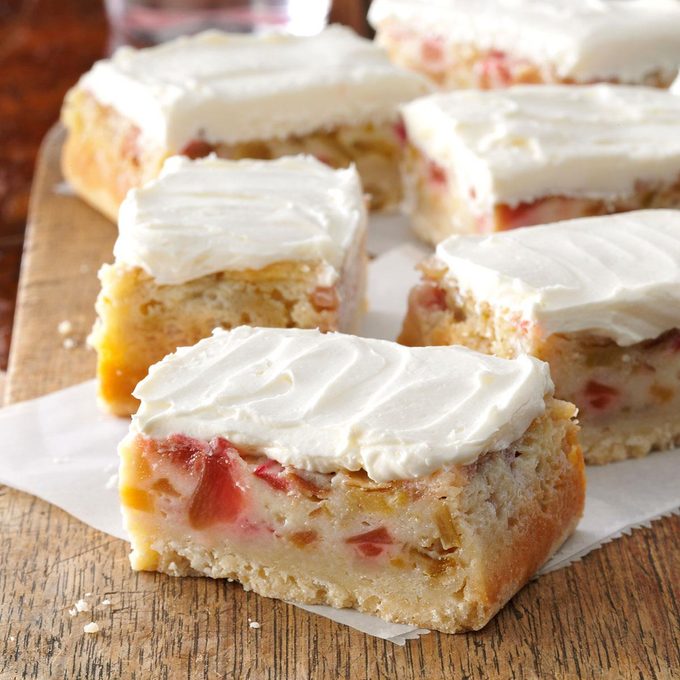
Rhubarb Custard Bars
One time I tried these rich, gooey bars, I but had to have the recipe so I could make them for my family and friends. The shortbreadlike chaff and the rhubarb and custard layers inspire people to find rhubarb that they can use to gear up a batch for themselves. —Shari Roach, South Milwaukee, Wisconsin
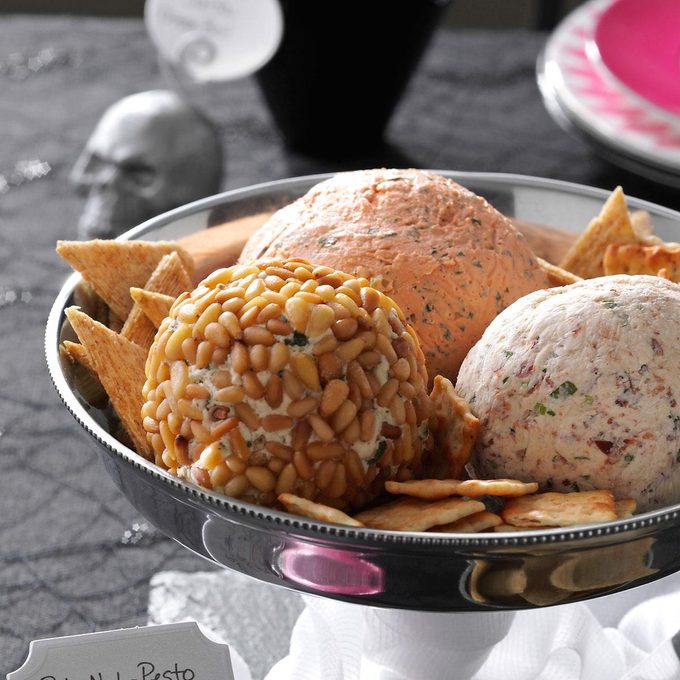
Celebration Cheese Balls
A scattering of simple ingredients that go together in minutes, iii fun flavorful options…these creamy cheese balls from our Exam Kitchen are a darling, do-ahead delight for busy holiday hostesses! Why not whip upwards several batches? —Gustation of Habitation Test Kitchen, Milwaukee, Wisconsin
Creamy Bratwurst Stew
A rich sauce coats this hearty combination of potatoes, carrots and bratwurst chunks. I adjusted a baked stew recipe that appeared in a newspaper. This is so comforting on cold winter evenings. —Susan Holmes, Germantown, Wisconsin
Winning Apple Crisp
I live in apple country, and a succulent crisp is one adept way to utilize them that doesn't take a lot of time. —Gertrude Bartnick, Portage, Wisconsin

























0 Response to "What Are Cheese Curds, and Why Do They Squeak?"
Post a Comment